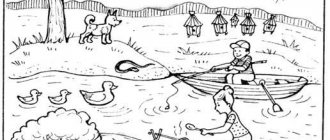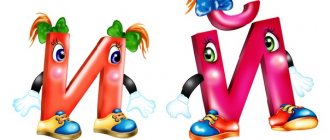Diagnostics: actions of the child that mean he is ready to learn to read and write
- Highlights sounds in words and poems that are often found there.
- Selects words according to a given phonemic feature (Name words starting with “c”, name words starting with “a”).
- Models words of 3-5 sounds and makes their sound analysis.
- When pronouncing a word, it correlates with the pattern of its sound composition (Compare what you see with what you hear).
- Changes the sound composition of a word, replaces sounds (Try replacing the first sound in the word “poppy” with “r” - what happens?)
- Selects words that are opposite and similar in meaning.
- Describes objects, selecting definitions of qualities and properties.
- Writes a short story on a topic that is relevant to you.
- Composes a story based on pictures, a series of plot pictures.
- Joins the group conversation and asks questions.
Alphabet for children 5 years old
Upon reaching the age of five, children, as a rule, already begin to show a conscious interest in reading. They already understand that letters make up words and words make up sentences. Therefore, at the age of 5, a child is already able to form letters, draw them, sculpt them, etc. without outside help.
Only from this age can you give your child electronic alphabet books - such objects are very captivating for children. But you need to choose such a primer wisely - so that when you press the buttons, the sound of the letter, and not its name, comes out of the speaker. You can also start using special workbooks (often they are called “Learning Letters”), which the child can study on his own or with his parents.
It is extremely important that at 5 years old the child speaks coherently and clearly. Based on this, you need to ask him to tell something as often as possible, for example, some kind of fairy tale or what he was doing today, etc.
The requirements imposed by elementary schools on the level of knowledge and skills of future first-graders are becoming higher every year. When going to first grade, a child should often not only know letters, but also be able to form words from them. In this regard, many modern parents have natural questions: “At what age and what is the best way to start teaching your child the alphabet?”
At what age should a child start teaching letters?
There are different opinions on this matter, but the general rule is this: the earlier you start, the easier it will be for your child to master this science. The main thing is that parents act wisely in their desire to stimulate the early development of the baby. The load must be adequate to the age or go with a slight advance, affecting the zone of proximal development. To help parents, a huge amount of didactic material has been created, aimed at each of the children's ages.
Experienced psychologists and teachers have developed many techniques, the use of which will allow a child to learn letters and start reading without much difficulty.
Early learning of the alphabet, and then reading, is not just a fad. The process of learning letters and combining them into words is interconnected with the general cognitive development of a person. Speech, thinking, concentration and stability of attention, motor functions - all these elements of the child’s psyche develop based on previous experience in close interaction with each other. Thus, when children study the alphabet, a comprehensive formation of mental functions necessary for life occurs.
From birth to 2 years.
Some developmental methods are designed to start classes with a child from birth. A newborn child is not just an organism with a set of unconditioned reflexes. When a little person is born, he already has a psyche and feels the need for new experiences that stimulate the development of brain structures. During this period, the child is as open as possible to receiving information, and this feature was precisely used by the authors of methods aimed at early learning to read. Of particular importance here is close communication between the child and mother - interaction during developmental games, tactile and auditory contacts. Only thanks to this symbiosis does the early development of the baby become possible.
The method of teaching children to read whole words, bypassing the phase of syllable-by-syllable reading, deserves attention. Regular classes on this author's development will contribute to the formation of automatic reading skills. It's hard to believe, but your child can learn to read before he speaks! The principles of natural development are used here: after all, no one explains to children the rules of the Russian language, when they begin to learn spoken language - the child’s brain develops and, based on its experience, independently forms the necessary semantic and logical connections. The same can happen with reading if an adult systematically and regularly works with a child as part of a didactic course. The main thing is not to miss the moment and follow the recommendations of the authors.
2 – 3 years.
At this age, perception, speech-motor functions, emotions, thinking and memory continue to actively develop. It is very easy to interest a child in something, but attention is still mobile and unstable. Learning the alphabet during this period can begin with all kinds of cards and cubes with letters. A prerequisite is to provide information to children in a playful way. Play is the leading activity of children from birth until they begin their education in first grade. It is through play that a child receives information about the world around him; it is through play that his development occurs. In early childhood, abstract symbols such as letters alone will not arouse the child's interest. For this to happen, he needs to be attracted to the game - bright, colorful, with visual elements and large details. For children of this age, it is important not only to see everything, but also to try it by touch and turn it in their hands. These age features must be taken into account if you decide to start teaching letters with your baby. Images of letters can be included in the game implicitly, and the sound of each symbol can be named and pronounced.
4-5 years.
The concentration of attention at this age stage is already higher than before, and many children can already listen intently to an adult for seven to ten minutes. During this short period of time, you can give the child information and see that in many cases he perceives and understands what you want to convey. This can only be achieved by maintaining interest. The main task of parents is to make sure that the process of introducing the baby to letters is colored with positive emotions for him. This is one of the conditions for the formation of correct motivation for learning. At the age of 4–5 years, the child begins to need role-playing games. He willingly tries on various images and experiments with social roles. This is the most important stage in a child’s development and knowledge of the world around him. And this feature of age can also be used when teaching the alphabet. For example, play school with your children - this will arouse keen interest and contribute to rapid development.
6-7 years.
Senior preschool age is a period when the child, in most cases, according to physiological and mental indicators, is already ready for learning, however, one must not forget that he is not yet a first grader, but is only preparing for this new stage in his life. If your child has no interest in the learning process, and you just can’t get your child to sit down with a copybook or primer, then you just need to change your approach.
There are many educational games for learning the alphabet, in which your child will receive information not in a boring and tedious way, memorizing incomprehensible icons, but with interest and immersion in the process itself. This is how you will develop your child’s readiness for school.
Alphabet for children 4 years old
For four-year-old children, classes are conducted in approximately the same way as in the previous case. The main focus is on games. It is recommended to continue making letters from available items. Be sure to supplement the process with new games. Here are a couple of them:
- Game "Find the picture". Make a set of pictures depicting objects with names beginning with all the letters. Lay out the pictures in front of the baby, name the letter and let him look for an object whose name begins with it.
- Game "Bag of Letters". Cut letters out of cardboard (or use special toy letters) and put them in a small bag. Give your child the task of putting a pen into the bag and trying to identify it by touch. After this, you can take out the letter to check whether the task was completed correctly.
Alphabet for children 3 years old
As we have already said, the first step in teaching a child the alphabet is to arouse his interest in it. In most cases, curiosity begins to manifest itself during the reading process. Your job is to cultivate and maintain this interest. By the age of three, children often begin to develop their favorite rhymes and fairy tales (if, of course, they were read to them), which means there is motivation to master the alphabet, because in the future the child will be able to read on his own.
So, how to teach a three-year-old child letters:
- Use letter cubes, banners, posters, and magnetic letters
- Draw letters with your child on paper, asphalt, snow, or a special board
- Compose letters from various objects that are at hand (sticks, matches, buttons); This exercise also helps develop fine motor skills.
When interacting with letters, begin to gradually explain to your child their meaning, sound, meaning. But remember that you need to study one letter at a time.
Alphabet for children 6 years old
Six years of age is considered the best age for perfect memorization of the alphabet and achieving a satisfactory level of reading. Moreover, if a child was unable to learn letters at 3 years old, at 6 years old he will do it 100%, and much faster.
ABCs, primers and magnets can also be used as teaching aids. It is recommended to start using copybooks and watch cartoons that teach letters and the peculiarities of constructing syllables and words. Some also use smartphones and tablets with themed applications, but this point is entirely at your discretion. We still recommend introducing children to books.
And one more thing: don’t be lazy and make an author’s primer with your baby. This is done very simply: a letter and a picture with the corresponding object are drawn on paper. Then all this is cut and pasted into a photo album or pasted into a regular album and reviewed regularly. If you simultaneously purchase simple books for your child, he will quickly master the skill of reading.
Now we will step back from reference to age and introduce you to three proven methods aimed at helping your child master the alphabet.







